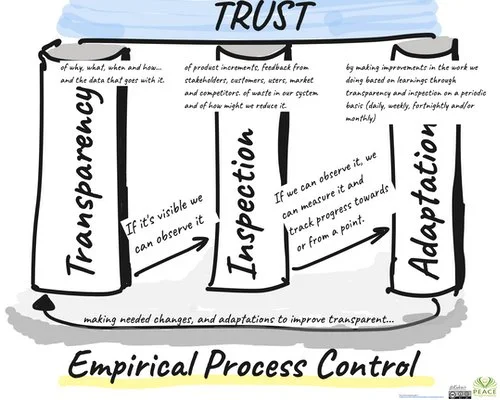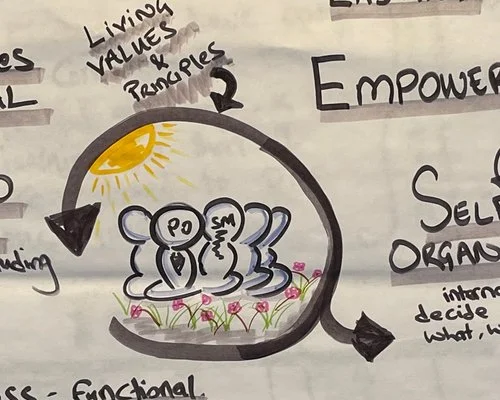What Is Agile Scrum?
To understand what agile scrum is, let us get back to basics. This is not an acronym or anything confusing, the term is actually inspired by a rugby scrum! In rugby, the team comes together in what they call a scrum to work together to move the ball forward. In this context, Scrum is where the team comes together to move the product forward.
Through my work as an agile transformation coach for Agilitea, a company I founded more than 14 years ago, I facilitate enterprise teams from startups to global corporations to improve their product, service development and operating models. Working with motivated leadership, tactical and operational teams I facilitate, coach, train, and mentor people and teams adopt Agile-Lean thinking and bring it to life through the Scrum framework.
What is Agile Scrum?
Before diving into the what, why and how of the Scrum framework, there are a few oddities I’d like to address.
When we hear Agile Scrum, it is a misnomer, since Scrum is one of many frameworks and methodologies that fall under the Agile-Lean umbrella, just Scrum or Scrum framework suffices.
Scrum is often referred to as a methodology, and that is inaccurate as Scrum is a framework, not a methodology. The two are different beasts! A framework is a loose and incomplete structure which leaves room for other practices to be included but provides much of the process required, whereas a methodology is a set of principles, tools and practices to be used to achieve a particular goal. Frameworks act as guides, whereas methodologies are more prescriptive.
Agile is often referred to as ‘Agile methodology’, Agile is not a methodology by itself, but rather a philosophy and mindset committed to tight feedback cycles, identifying and addressing waste and continuous improvement. Agile isn't defined by a specific set of meetings. Events. workshops nor any specific development technique. Agile is an umbrella term for a growing and evolving group of frameworks and methodologies.
“Language is important, language allows us to resolve misunderstandings that exist because of language.” Stefan ‘big bear’ Swoboda.
In plain english, Scrum is a lightweight, simple framework that helps people in teams self-manage the work needed to achieve a defined outcome. The Scrum guide defines scrum as a “...a lightweight framework that helps people, teams and organisations generate value through adaptive solutions for complex problems.”
Scrum is easy to implement because it is lightweight; contains a minimum set of needed elements (more on these later), however Scrum is difficult to master, even when we’re working with motivated individuals, teams and leadership.
Personally I see Scrum as a minimum viable approach to bring Agile/Agility to life in individuals, teams, communities and enterprises.
The word it self has been adopted from Rugby, the sport not the town, though there is a connection there. In Rugby the word is scrummage, commonly known as Scrum, it is a method of restarting play that involves players packing closely together with their heads down and attempting to gain possession of the ball. Read that as a Team collaborating closely together and attempting achieve a goal.
For those unfamiliar with Agile and Scrum, I hope I’ve satisfied your curiosity as to what is Scrum methodology?
Scrum theory and values - a scrum framework
In order to understand Scrum I advocate starting with empirical process control, a fancy way of saying ‘experiential, evidence based learning’, which relies on the three main ideas of transparency, inspection, and adaptation.
Scrum, as per the guide “..is founded on empiricism and lean thinking. Empiricism asserts that knowledge comes from experience and making decisions based on what is observed. Lean thinking reduces waste and focuses on the essentials.” And explore what values and behaviour is best suited to bring empiricism to life. The authors of Scrum did well to recognise what sort of person would they, we, I want to collaborate and co-create with?
The Scrum guide states “Successful use of Scrum depends on people becoming more proficient in living five values:Commitment, Focus, Openness, Respect, and Courage”, I say thank you however these are basic values needed to be a decent human being! Here's a story I wrote to make these values more personal and connected to how we turn up in all our relationships.
As a ______
I want the courage to have open conversations, that are respectful of people and focused on our learning, so that I remain committed to our continuous improvement.
I encourage you to fill in the blank for yourself and see where it leads to!
Why adopt the Scrum framework in your business?
The benefits of creating an agile work environment are myriad for people, teams, communities and enterprises regardless of their size or complexity.
Agile ways of working means inspecting, adapting, responding to change and complexity in your ecosystem. This is as relevant to street vendors in Karachi, Sanaa and Cairo as it is to global corporations. Rigid work practices that do not adapt to economic, social, legal, technological or political changes are not able to function to their full potential. For example, responding to employee mental and physical health needs makes for a workforce that has the needed environment to reach their full potential.
But this does not mean merely ‘going with the flow’, measures and boundaries need to be in place, and processes thought out and implemented, to allow for organic growth while consistently monitoring commercial success and financial growth. This is where a Scrum framework can form the basis for success for any business.
How to bring a Scrum framework to your business
Whenever I am asked ‘how might we get started with Scrum?’ I point to and reflect back to an essay written by Tobias Mayer, a titan in the agile space - Scrum: a 5-step guide for managers. It was back in 2013 that Tobias wrote the essay and here we are in 2023, still being asked the same/similar questions.
Getting started with Scrum is simple, however unlearning our old ways, and changing the old systems to make way for new ways of working is hard. Each team’s journey is unique, as is that of each enterprise embarking on adopting Agile-Lean via Scrum.
My two pence worth on top of Tobais’s guidance on getting started with Scrum is to start small, build the discipline, realise the value and explore scaling agile ways of working across the organisation. The environment Scrum teams operate are influenced, governed and managed more so by supporting functions rather than the team itself. Explore how might people and development (HR), legal, finance and operations benefit from adopting Agile-Lean thinking? And how might that nurture the needed culture for creative teams to thrive in?
Learning more about Scrum and becoming part of the global Scrum community
As a successful agile practitioner I have lectured in agile-lean thinking and the Scrum framework across the globe. I attend global Scrum gatherings and talk online and in person to CEOs and agile-curious teams about how to make people, teams, communities, enterprises and society become agile.
To further your knowledge or practise your agile craft I strongly encourage all curious types to connect with your local agile community, attend regional and global Scrum gatherings, add to and learn from the wisdom of the community. By joining and being a part of the community you can not only benefit from greater product success but also a better work/life balance and improved team building skills.
To find out more, chat about Scrum frameworks over a cuppa, or to book me to bring agile methodology to your workplace, you can book a free transformation coach consultation with me by clicking here.










